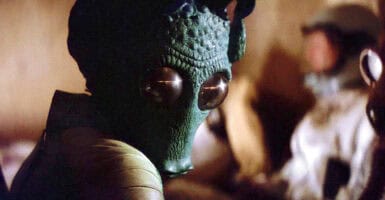James Cameron Is Considering Making The Avatar Sequels At 48 Frames Per Second
This article is more than 2 years old
![]()
This Friday we will know if the future of cinema will be 48 FPS after the release of The Hobbit: An Unexpected Journey. Director James Cameron attended the world premiere of the film in Wellington, New Zealand and hopes the new technology will catch on with general audiences. Although filming hasn’t started on the Avatar sequels, the Oscar-winning director is considering shooting both films at the higher frame rate.
In a new interview, visual effects supervisor Joe Letteri, who worked with Peter Jackson on The Hobbit: An Unexpected Journey, says that he believes the future of filmmaking will be with the high-frame-rate format. Letteri and his team at WETA will be working with James Cameron on the Avatar sequels, and he thinks the possibility is high for Cameron to be swayed by the tech. Letteri says:
Jim’s still thinking 60, because it’s a persistence of vision artifacts and to quote Doug Trumbull and the studies he’s done, he says it tends to go away at around 64. I tend to agree with him from the tests we’ve done. We’ve gone to pretty high frame rates and after about 64, the returns are pretty minimal and to tell you the truth, the difference between 48 and 60 is not as noticeable as the difference between 24 and 48 so for practical reasons, we decided to go with 48 because asking the theaters to have projectors and servers that could handle 60 was not really practical in the time frame we had for ‘Hobbit’ plus it would have meant even more work, double the amount of work, that we were already committed to at 48 frames.
While 48 FPS didn’t work well for some in The Hobbit: An Unexpected Journey, it just might be the way to go with the Avatar sequels. The big difference between Middle Earth and Pandora is that Pandora is almost completely made in a computer, while Middle Earth is (somewhat) tangible. In IMAX 3D HFR, you could easily see the seams in The Hobbit, whereas it might come out flawless with the Avatar sequels. Since the eye translates images at 60 FPS — which is why Cameron and Letteri were shooting test footage at this higher frame rate — Pandora might actually seem like a real alien planet.
Whether or not 48 FPS will be successful for The Hobbit: An Unexpected Journey, it’s most likely this will be the new technique when making a 3D movie. Director Bryan Singer raved about the higher frame rate at The Hobbit’s world premiere too, and is considering shooting X-Men: Days of Future Past in 48 FPS. Maybe Star Wars: Episode VII will be an IMAX 3D 48HFR movie in 2015.












